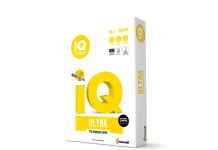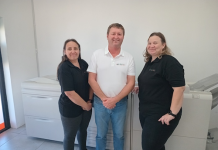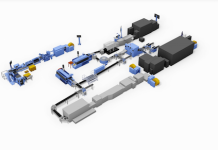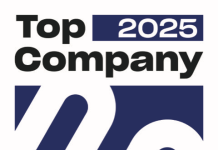The new RICOH TH6310F that uses a thin film piezo actuator (a kind of piezoelectric transducer that creates mechanical deformation by applying a voltage used for jetting drops of ink), and is a key component in digital printing systems, will be launched as the flagship model among Ricoh’s family of industrial inkjet printheads.
Using its high firing frequencies, it is the most productive inkjet printhead by Ricoh for both single or multi-pass applications. It uses Micro-Electro-Mechanical-Systems (MEMS): a general term for miniatured electro-mechanical devices or technology. The technology enables high jetting accuracy, while its unique nozzle layout yields print quality even at high gap printing (printing that requires distance between the printhead and the media, such as printing on uneven surfaces) required in textile and other applications. At the same time, the ink recirculation structure significantly reduces the risk of jetting failure, ensuring high drop ejection stability.
In the industrial print market for textiles, corrugated cardboards, labels and other products, there is an increasing demand to meet a variety of customer needs, including smaller run sizes and shorter delivery times. These needs are being addressed by the rapid digitalisation of industrial print, contributing to overall greater flexibility, efficiency and productivity. These shifting and expanding requirements call for increasing demand for inkjet printheads that offer higher productivity and high-resolution printing.
Ricoh’s unique highly-integrated design using MEMS technology has achieved a 6.6cm printing width with an array of 1600 nozzles (staggered array of nozzle rows with 75npi per row) by configuring two modules of 100 x 8 rows. It is also capable of using fine droplet ejection.
Furthermore, the nozzle layout is designed to prevent airflow from ejected ink droplets from affecting adjacent droplets and resulting image quality, enabling high-quality printing even with a 4mm gap (depends on the combination of ink and print media used).
The ink recirculation structure continuously circulates ink behind the nozzle. This structure significantly reduces the risk of nozzle drying, ink particle sedimentation, and other jetting failures, thus ensuring ejection reliability and printhead productivity. This provides increased reliability for single-pass (the printhead remains in a fixed position and completes image printing in a single pass while the print material is conveyed underneath) – printing of 100m/min or more.
It is compatible with Aqueous-based, UV and Solvent inks and can be used in a wide range of industrial applications, including textiles, corrugated cardboards, labels, binder jet, and signage graphics.
Ink ports offer a simple one in, one out system that can be easily integrated into printing systems. To function ink circulation, one ink port (inlet for ink delivery) is located on the ink supply side and one on the ink discharge side.
The new Dual Vcom (two types of drive waveforms can be selected for each nozzle to shorten the drive cycle) function achieves superior jetting frequency of up to 40kHz in multi-drop mode.
RICOH
https://www.ricoh.com/





















